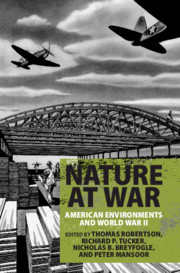Book contents
- Nature at War
- Nature at War
- Copyright page
- Contents
- Figures
- Tables and Charts
- Maps
- Contributors
- Preface
- Acknowledgments
- Introduction
- Part I New Weapons, New Spaces
- Part II Military Materials I (metals and energy)
- Part III Military Materials II (foods and plants)
- Part IV New Landscapes
- Part V New Frontiers
- 10 Battling Insects and Infection
- 11 Shattered Worlds
- Part VI Conservation
- Index
11 - Shattered Worlds
Place, Environment, and Militarized Landscapes at the Dawn of Atomic America
from Part V - New Frontiers
Published online by Cambridge University Press: 25 March 2020
- Nature at War
- Nature at War
- Copyright page
- Contents
- Figures
- Tables and Charts
- Maps
- Contributors
- Preface
- Acknowledgments
- Introduction
- Part I New Weapons, New Spaces
- Part II Military Materials I (metals and energy)
- Part III Military Materials II (foods and plants)
- Part IV New Landscapes
- Part V New Frontiers
- 10 Battling Insects and Infection
- 11 Shattered Worlds
- Part VI Conservation
- Index
Summary
On a cool morning in the isolated southern New Mexico desert, scientists and military personnel gathered for what they knew would be one of the twentieth century’s most historic moments. Three … Two … One … A thunder roared across the desert. It was July 16, 1945, at 5:29:45 am Mountain Standard Time. The assembled onlookers watched the first successful atomic device explode at the Trinity site 50 miles northwest of Alamogordo, New Mexico. No one knew for certain what would happen. Everyone shielded themselves with protective eyewear and were told to turn away from the blast. Manhattan Project scientist Enrico Fermi took bets as to whether the fission-type plutonium implosion weapon would annihilate New Mexico or the entire world.1 When the test came to an end, a 6-foot-deep crater with a 250-foot radius was left behind. At the equivalent of 20 kilotons of TNT, it was the largest explosion in human history. The blast destroyed vegetation two thousand feet from ground zero.2
- Type
- Chapter
- Information
- Nature at WarAmerican Environments and World War II, pp. 298 - 322Publisher: Cambridge University PressPrint publication year: 2020

